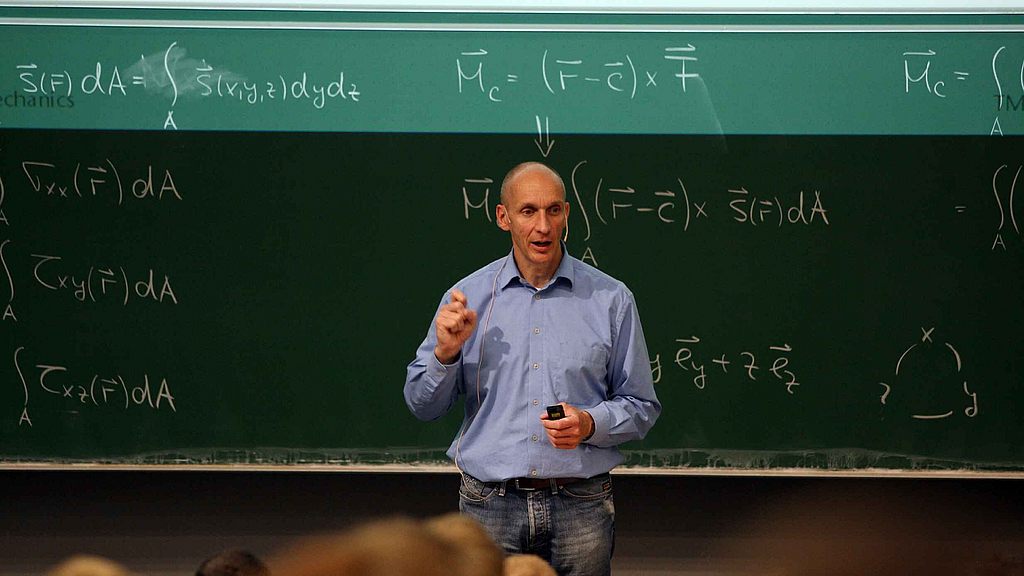Teaching concept
The Division of Solid Mechanics provides a number of compulsory and elective courses both to educate all students in the fundamentals of Engineering Mechanics and to provide additional advanced tasks, which are necessary in their forthcoming studies and which is a required knowledge in industry for understanding mechanical applications. These lectures are
The courses of Engineering Mechanics represent a historically established knowledge and form the basis for advanced research courses in engineering. In these lectures, one learns basic skills, using simple methods to estimate daily practical applications of smaller structures. In particular, the courses provide the basic knowledge of engineering design, durability, control engineering or metal forming. Of course, there are difficulties for students in theory-oriented lectures which require are larger effort than in most courses on applied sciences. However, we provide by office hours and a collection of lecture notes all necessary information.
A question that is put to this is as follows: What aids requires an engineer if he and the theories of Engineering Mechanics, which are mainly developed for simple linear systems and structural elements (rods, beams, shafts), are no longer applicable? For this purpose numerical methods are necessary, i.e. the use of computerprograms (and the algorithms within the software) to predict the behavior of components is required. One of the methods of daily practice is represented by the Finite Element Method. Therefore, this lecture is offered by the Division of Solid Mechanics.
Most processes are, however, from the issues in which the mechanical behavior of a component in its everyday use or during its manufacturing process is non-linear. On the one hand, the material behavior deviates from linearity or it may depend even stronger from the process history, which significantly affects the component life. This is discussed in the lecture as well.
On the other hand, the geometric description of the motion or deformation must incorporate geometrical non-linear effects. Therefore, research-related topics are taught in an additional elective course. Moreover, in any theory manual to finite element programs such as ANSYS, ABAQUS, MARC or LS-DYNA the engineer or designer is confronted with the term of a tensor. Many lectures are based on the fundamentals of tensor calculus, such as fluid mechanics, continuum mechanics, finite element method in the consideration of nonlinear material behavior and also the description of geometry. Thus, companies increasingly look for CAD engineers, which are able to treat highly complex physical processes, which occur in high technology, automotive industry or in aerospace technology. One has only time during the studies at the University to devote to these topics.
Therefore, we offer Continuum Mechanics the lecture in which is the prerequisite tensor analysis is provided. It will also be helpful for the finite elements course.
Why prerequisite? In Engineering Mechanics one learns only the basics of linear kinematics of components. In Continuum Mechanics, however, the general description of arbitrary deformations (large distortions, large displacements) is carried out (and one notices linearizing these relations that one obtains the basic equations of Engineering Mechanics II). Especially, in metal forming processes or in fluid mechanics, such geometrical non-linear relations are necessary. The mathematical representation of Tensor Calculus is also necessary to describe the three-dimensional material behavior of plastics, rubber or metals because each stress state of a body is not limited to one-dimensional tensile problems. Therefore, constitutive models of viscoelasticity, plasticity and viscoplasticity are treated in the lecture on finite elements for three-dimensional applications. These models are required within the finite element method to calculate inelastic components as well.
For these lectures notes and collections of exercises have been developed as a tool to study the content of the lectures. Accordingly, we invite you to this cycle of lectures, required in daily practical applications and research as well (not only in mechanics, but especially in materials engineering applications).
In addition, we offer studies and theses that are experimentally, theoretically or numerically oriented. In this context, we seek students for research projects, Bachelor and Master theses, which are interested in experimental, theoretical or numerical oriented problems. On the one hand we provide fixed tasks and, on the other hand, we fit topics to the prior knowledge of the students.
